Competition to Connect Human Brains to Computers Intensifies
Medical trials have consistently indicated that brain implants, once confined to the realm of science fiction, could have a significant role in shaping the future of humanity.
Billions of dollars are pouring into a clutch of specialty companies looking for treatments for some of the most debilitating ailments.
And pioneering research has already produced results.
Paralyzed in a motorcycle accident in May, a Dutchman regained the ability to walk thanks to implants that reconnected his brain and spinal cord.
This experiment was one of several eye-catching experiments that have helped create a huge buzz in the industry.
According to UNESCO, in the decade to 2020, investors invested more than $30 billion in neurotechnology more broadly.
And the money has continued to flood in, thanks in part to rapid improvements in artificial intelligence (AI), which researchers have used to interpret data from the implants.
Tech titan Elon Musk has refocused energy on his company Neuralink after receiving approval in May to test its implants on humans, helping it raise $280 million in funding.
And other companies with less prominent bosses are proliferating, offering hope to patients suffering from ailments ranging from rare nerve diseases to severe epilepsy.
– ‘The Turning Point’ –
Founded more than ten years ago, Synchron raised $75 million this year with the backing of Microsoft founder Bill Gates and Amazon’s Jeff Bezos.
The company received permission from US authorities in 2021 to test its implant, and has since distributed it to nine people with amyotrophic lateral sclerosis (ALS), the motor nerve disease that physicist Stephen Hawking suffered from.
Its implant allows patients to use messaging apps or browse the web using only eye movements and thoughts.
One of the biggest selling points is that unlike other implants, it does not require invasive surgery.
The first goals of the Synchron test, said Dr. David Putrino, who oversaw the medical research at Mount Sinai Hospital in New York, were to make sure the implant was safe and could monitor the brain for long periods of time.
According to him, the trial was successful on both fronts.
Synchron founder Tom Oxley believes the technology, known as brain-computer interface (BCI), is now at a “tipping point”.
The industry must work to make implants widely available, he told AFP.
– Brainstorming –
There are still some pretty heavy hurdles before that can happen, not the least of which is that the most effective results often come with the most invasive implants.
For example, US patient Ian Burkhart, who was paralyzed from the neck down after a diving accident, told AFP that receiving an implant that allowed him to control his hands and arms was a “magical moment”.
But he could only ever do that in a lab, and the implant, known as the Utah array, was far from comfortable.
“The brain doesn’t like having stuff inside it,” said Michael Platt, a professor of neuroscience at the University of Pennsylvania.
“And so the brain’s immune system attacks these devices,” he said of the Utah systems.
When implants become covered in cells, they are unable to transmit signals from the brain and function less well.
Although far less advanced, some researchers are pinning their hopes on non-implant techniques.
In May, researchers at the University of Texas at Austin said they used brain scans and artificial intelligence modeling to get a “core” of what people think.
The technology relied heavily on GPT models developed by OpenAI, which are able to analyze huge chunks of data faster and faster.
But such research is in its very early stages and involves patients who spend up to 16 hours each time in an MRI scanner.
– Musk’s telepathy plan –
While most industry players focus exclusively on the medical uses of neurotechnology, Musk is different.
The maverick tycoon touts the possibility of telepathy using technology to store memories or allow people to continue to exist without their bodies.
“In the future, you will be able to store and replay memories,” he told the Neuralink event in 2020.
“You could potentially load them into a new body or robot body.”
These claims are far from reality, but that hasn’t stopped Musk from going even further.
He sees implants as a way to improve human functioning—a move he believes is vital if our species is to co-exist with super-intelligent machines.
“That might be the most important thing a device like this accomplishes,” he said.




